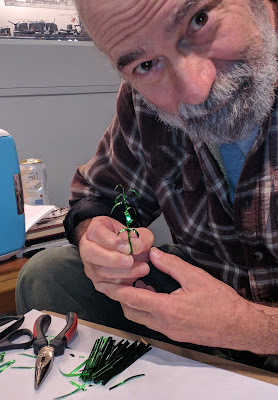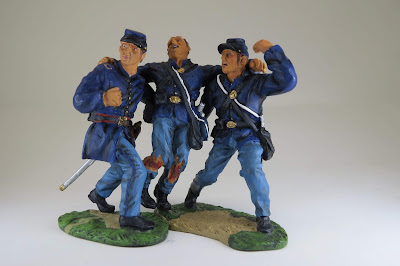For quite some time I've wanted to make a cornfield. This past weekend I turned my attention to it.
W. Britains makes very nice corn stalks but they are quite pricey, and they're growning in straight rows, which you'd never see in the days before mechanized farming.
As I continue to collect W. Britain's Iron Brigade toy soldiers I want to incorporate them into my ongoing interest (personal and professional) in the Battle of Antietam. In the opening hours of the battle, the Iron Brigade was involved in the bloody fight that has become known simply, and universally, as "the Cornfield". Hence my need for corn. But this crop I was going to grow myself, more cheaply than the store-bought version and more satisfying as I'd be making it myself.
A few years ago I had the idea of using twist ties to make the corn stalks. Two weeks ago I decided that the time had come and I went to Amazon and bought several hundred 4" ties for less than five dollars.
The only problem was that they were a very shiny green...that problem would be dealt with later on.
I gathered together nine of the ties and started twisting them from the bottom up, pausing now and then to bend down the long leaves of the stalk.
The square ends of the leaves were trimmed into a point.
The four-inch ties made stalks of the perfect height for the soldiers.
One down, nineteen to go.
Everything was moved out to the woodshop and I continued the process using my spray booth to apply primer to the stalks.
As the paint dried I moved to the band saw where I cut square bases out of scrap pieces of MDF.
Adhesive was applied to each base with a caulking gun and wide putty knife.
I textured each base by liberally sprinkling sawdust over the adhesive.
When everything was cured I started the painting process; an undercoat of brick red with a light overcoat of tan, and then a brush to apply three values of green.
With a pencil I marked the spots where the cornstalks would sprout from, and began drilling holes.
Finally I started plugging the stalks into the holes in the base in a nice, random, period-correct, pattern.
The finished product is comprised of twenty stalks.
Eventually, I want to make four of these units, that can then be put together for a good sized crop.
Cornfield completed, now it comes to the battle, as General John Gibbon leads his Iron Brigade up the Hagerstown Pike and deploys in the Cornfield in support of Battery B, 4th US Artillery.
This whole project took about a day and a half to complete.
I continue to collect Iron Brigaders...so I'm going to need a lot more corn!
Until next time...
Soldier on!
Mannie





















































